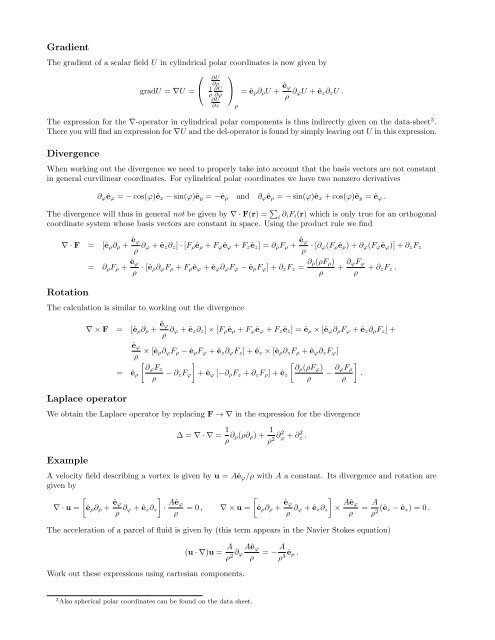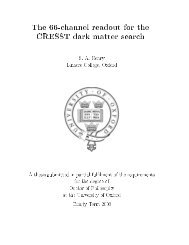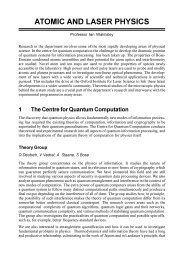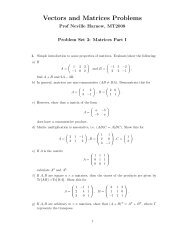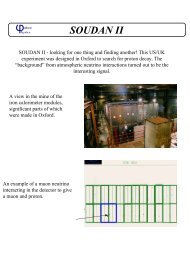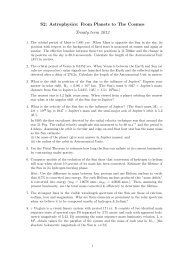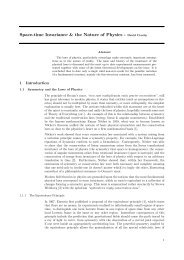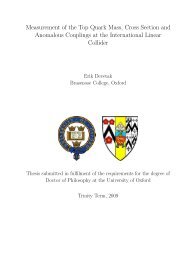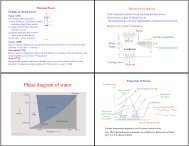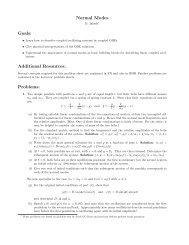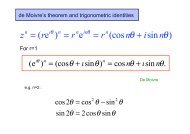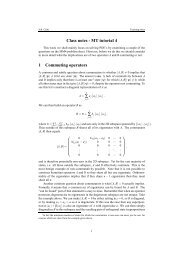Vector calculus in curvilinear coordinates Goals: Coordinate ...
Vector calculus in curvilinear coordinates Goals: Coordinate ...
Vector calculus in curvilinear coordinates Goals: Coordinate ...
Create successful ePaper yourself
Turn your PDF publications into a flip-book with our unique Google optimized e-Paper software.
Gradient<br />
The gradient of a scalar field U <strong>in</strong> cyl<strong>in</strong>drical polar coord<strong>in</strong>ates is now given by<br />
⎛<br />
gradU = ∇U = ⎝<br />
∂U<br />
∂ρ<br />
1 ∂U<br />
ρ ∂ϕ<br />
∂U<br />
∂z<br />
⎞<br />
⎠<br />
p<br />
= ê ρ ∂ ρ U + êϕ<br />
ρ ∂ ϕU + ê z ∂ z U .<br />
The expression for the ∇-operator <strong>in</strong> cyl<strong>in</strong>drical polar components is thus <strong>in</strong>directly given on the data-sheet 3 .<br />
There you will f<strong>in</strong>d an expression for ∇U and the del-operator is found by simply leav<strong>in</strong>g out U <strong>in</strong> this expression.<br />
Divergence<br />
When work<strong>in</strong>g out the divergence we need to properly take <strong>in</strong>to account that the basis vectors are not constant<br />
<strong>in</strong> general curvil<strong>in</strong>ear coord<strong>in</strong>ates. For cyl<strong>in</strong>drical polar coord<strong>in</strong>ates we have two nonzero derivatives<br />
∂ ϕ ê ϕ = − cos(ϕ)ê x − s<strong>in</strong>(ϕ)ê y = −ê ρ and ∂ ϕ ê ρ = − s<strong>in</strong>(ϕ)ê x + cos(ϕ)ê y = ê ϕ .<br />
The divergence will thus <strong>in</strong> general not be given by ∇ · F(r) = ∑ i ∂ iF i (r) which is only true for an orthogonal<br />
coord<strong>in</strong>ate system whose basis vectors are constant <strong>in</strong> space. Us<strong>in</strong>g the product rule we f<strong>in</strong>d<br />
∇ · F = [ê ρ ∂ ρ + êϕ<br />
ρ ∂ ϕ + ê z ∂ z ] · [F ρ ê ρ + F ϕ ê ϕ + F z ê z ] = ∂ ρ F ρ + êϕ<br />
ρ · [∂ ϕ(F ρ ê ρ ) + ∂ ϕ (F ϕ ê ϕ )] + ∂ z F z<br />
Rotation<br />
= ∂ ρ F ρ + êϕ<br />
ρ · [ê ρ∂ ϕ F ρ + F ρ ê ϕ + ê ϕ ∂ ϕ F ϕ − ê ρ F ϕ ] + ∂ z F z = ∂ ρ(ρF ρ )<br />
+ ∂ ϕF ϕ<br />
+ ∂ z F z .<br />
ρ ρ<br />
The calculation is similar to work<strong>in</strong>g out the divergence<br />
∇ × F = [ê ρ ∂ ρ + êϕ<br />
ρ ∂ ϕ + ê z ∂ z ] × [F ρ ê ρ + F ϕ ê ϕ + F z ê z ] = ê ρ × [ê ϕ ∂ ρ F ϕ + ê z ∂ ρ F z ] +<br />
ê ϕ<br />
ρ × [ê ρ∂ ϕ F ρ − ê ρ F ϕ + ê z ∂ ϕ F z ] + ê z × [ê ρ ∂ z F ρ + ê ϕ ∂ z F ϕ ]<br />
= ê ρ<br />
[<br />
∂ϕ F z<br />
ρ<br />
]<br />
[<br />
∂ρ (ρF ϕ )<br />
− ∂ z F ϕ + ê ϕ [−∂ ρ F z + ∂ z F ρ ] + ê z − ∂ ]<br />
ϕF ρ<br />
.<br />
ρ ρ<br />
Laplace operator<br />
We obta<strong>in</strong> the Laplace operator by replac<strong>in</strong>g F → ∇ <strong>in</strong> the expression for the divergence<br />
∆ = ∇ · ∇ = 1 ρ ∂ ρ(ρ∂ ρ ) + 1 ρ 2 ∂2 ϕ + ∂ 2 z .<br />
Example<br />
A velocity field describ<strong>in</strong>g a vortex is given by u = Aê ϕ /ρ with A a constant. Its divergence and rotation are<br />
given by<br />
[<br />
]<br />
∇ · u = ê ρ ∂ ρ + êϕ<br />
ρ ∂ ϕ + ê z ∂ z · Aê [<br />
]<br />
ϕ<br />
= 0 , ∇ × u = ê ρ ∂ ρ + êϕ<br />
ρ<br />
ρ ∂ ϕ + ê z ∂ z × Aê ϕ<br />
= A ρ ρ 2 (ê z − ê z ) = 0 .<br />
The acceleration of a parcel of fluid is given by (this term appears <strong>in</strong> the Navier Stokes equation)<br />
(u · ∇)u = A ρ 2 ∂ Aê ϕ<br />
ϕ = − A ρ ρ 3 êρ .<br />
Work out these expressions us<strong>in</strong>g cartesian components.<br />
3 Also spherical polar coord<strong>in</strong>ates can be found on the data sheet.


